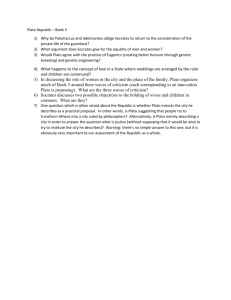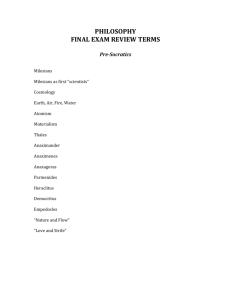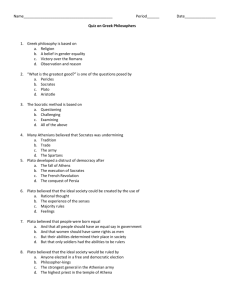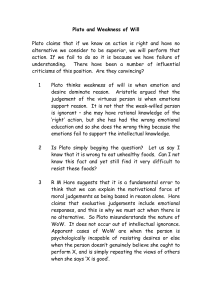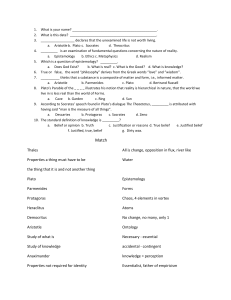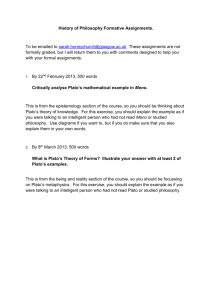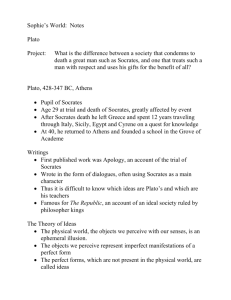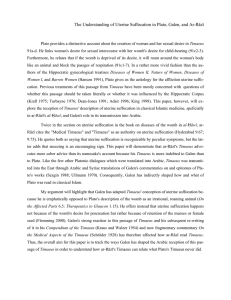On Hippocrates and Plato
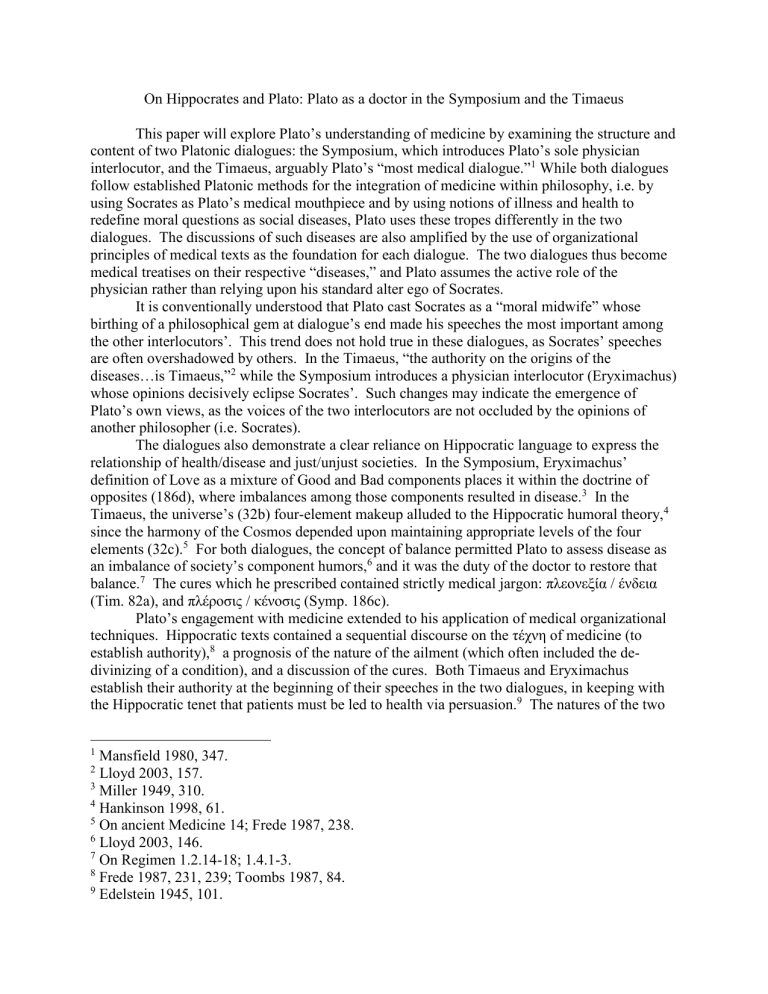
On Hippocrates and Plato: Plato as a doctor in the Symposium and the Timaeus
This paper will explore Plato’s understanding of medicine by examining the structure and content of two Platonic dialogues: the Symposium, which introduces Plato’s sole physician interlocutor, and the Timaeus, arguably Plato’s “most medical dialogue.”
1
While both dialogues follow established Platonic methods for the integration of medicine within philosophy, i.e. by using Socrates as Plato’s medical mouthpiece and by using notions of illness and health to redefine moral questions as social diseases, Plato uses these tropes differently in the two dialogues. The discussions of such diseases are also amplified by the use of organizational principles of medical texts as the foundation for each dialogue. The two dialogues thus become medical treatises on their respective “diseases,” and Plato assumes the active role of the physician rather than relying upon his standard alter ego of Socrates.
It is conventionally understood that Plato cast Socrates as a “moral midwife” whose birthing of a philosophical gem at dialogue’s end made his speeches the most important among the other interlocutors’. This trend does not hold true in these dialogues, as Socrates’ speeches are often overshadowed by others. In the Timaeus, “the authority on the origins of the diseases…is Timaeus,” 2
while the Symposium introduces a physician interlocutor (Eryximachus) whose opinions decisively eclipse Socrates’. Such changes may indicate the emergence of
Plato’s own views, as the voices of the two interlocutors are not occluded by the opinions of another philosopher (i.e. Socrates).
The dialogues also demonstrate a clear reliance on Hippocratic language to express the relationship of health/disease and just/unjust societies. In the Symposium, Eryximachus’ definition of Love as a mixture of Good and Bad components places it within the doctrine of opposites (186d), where imbalances among those components resulted in disease.
3
In the
Timaeus, the universe’s (32b) four-element makeup alluded to the Hippocratic humoral theory,
4 since the harmony of the Cosmos depended upon maintaining appropriate levels of the four elements (32c).
5
For both dialogues, the concept of balance permitted Plato to assess disease as an imbalance of society’s component humors,
6
and it was the duty of the doctor to restore that balance.
7
The cures which he prescribed contained strictly medical jargon: πλεονεξία / ένδεια
(Tim. 82a), and πλέροσις / κένοσις (Symp. 186c).
Plato’s engagement with medicine extended to his application of medical organizational techniques. Hippocratic texts contained a sequential discourse on the τέχνη of medicine (to establish authority), 8 a prognosis of the nature of the ailment (which often included the dedivinizing of a condition), and a discussion of the cures. Both Timaeus and Eryximachus establish their authority at the beginning of their speeches in the two dialogues, in keeping with the Hippocratic tenet that patients must be led to health via persuasion.
9
The natures of the two
1
Mansfield 1980, 347.
2 Lloyd 2003, 157.
3
Miller 1949, 310.
4
Hankinson 1998, 61.
5
On ancient Medicine 14; Frede 1987, 238.
6
Lloyd 2003, 146.
7
On Regimen 1.2.14-18; 1.4.1-3.
8
Frede 1987, 231, 239; Toombs 1987, 84.
9 Edelstein 1945, 101.
ailments and their corresponding treatments are discussed extensively and secularly, albeit along slightly different lines. The Timaeus appears to follow the model of a comprehensive medical examination of a particular condition, such as On the Sacred Disease, while the sequence of treatments in the Symposium follows a medical progression like that in Aphorisms 7.87.
If a medical treatise is defined as a text containing both a definition of a disease and a variety of cures, one may safely assign the Timaeus and the Symposium to those ranks. Here it is
Plato who occupies the role of the physician, and his construction and arrangement of the speeches within the two works serve to diagnose and treat society with respect to a moral quandary. In both dialogues, Plato’s cure was unanimously accepted, thereby testifying to his persuasive prowess (again, a mark of the good physician).
Bibliography:
* Edelstein, L. 1945. “The Role of Eryximachus in Plato’s Symposium,” TAPhA 76: 85-103.
* Frede, M. 1987. “Philosophy and Medicine in Antiquity,” in M. Frede, Essays in Ancient
Philosophy. Minneapolis: University of Minnesota Press. 225-242.
* Hankinson, R. J. 1998. Cause and Explanation in Ancient Greek Thought. Oxford: Clarendon
Press.
* Lloyd, G.E.R. 2003. In the Grip of Disease: Studies in the Greek Imagination. Oxford: Oxford
University Press.
* Mansfield, J. 1980. “Plato and the Method of Hippocrates,” GRBS 21.4: 341-362.
* Miller, H. 1945. “Aristophanes and Medical Language,” TAPhA 76: 74-84.
* Toombs, S. Kay. 1987. “Medicine and the Patient-Physician Relationship in Ancient Greece,” in R. M. Baird et al., eds., Contemporary Essays on Greek Ideas: The Kilgore Festschrift.
Waco, TX: Baylor University Press. 75-87.

